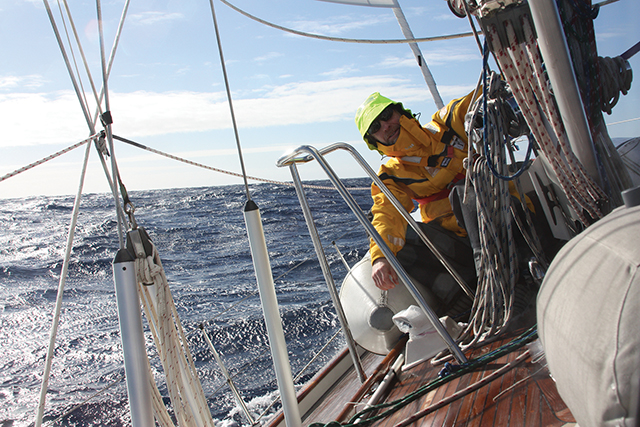Sometimes the road to paradise is paved with bad weather (published April 2012)
May 8, 2010, 0730 hrs,
36.56 S, 176.54 E
Log: 136,080 miles
At sea, headed toward New Zealand’s East Cape
Motorsailing at 6.5 knots in
5 knot N winds
Baro: 1017.2, Cabin temp: 68 F, Cockpit: 65 F, Sea water: 68 F
WE’VE SET SAIL FOR TAHITI!
I had been watching the always-changing weather for a month, and had made a couple visits to Bob McDavitt at MetService New Zealand’s Westhaven Marina office, but Wednesday night, the weather picture changed. A low formed NW of NZ and was predicted to deepen and slowly meander toward the northern tip of NZ. Thursday night, Bob ran a detailed analysis based on our leaving Friday at noon. The computer recommendation of the most efficient routing looked like the letter W! Our first goal is to get to East Cape to catch the tail end of the large high pressure that had favored NZ with sunny, dry and relatively calm conditions for nearly a week, thus avoiding forecasted storm force winds for northern NZ.
With a weather goal in mind, we asked our crew to join us two hours earlier than scheduled so we could obtain an earlier outbound clearance. We had moderate conditions leaving the Hauraki Gulf and cleared Channel Island to set sail ESE for East Cape. Last night, we were able to sail occasionally, but mostly the winds have been around 5-7 knots. Every chance we get, we shut down the engine and sail, sometimes for a few hours, sometimes for a few minutes, but always with the goal of getting far enough south and east to avoid the bumpy conditions. The GRIB weather file that we just received from www.saildocs.com shows an even more favorable forecast for the next three days, based on our reaching East Cape before turning NE towards Tahiti.
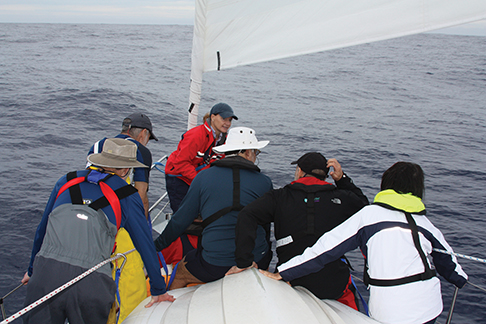
We have a strong crew, eager to improve their offshore skills for different reasons. Felipe and Marta are keen to take part in the Blue Water Around the World Rally, Seth will be taking delivery of a new Malo 40 this July, and we also have a couple of keen SF Bay sailors and a vet from North Carolina.
May 19, 2010, 0730 hrs,
27.10 S, 160.54 E
Log: 137,697 miles—591 miles to Rurutu, Austral Islands
Beam reaching at 8 knots in 16 knot SE winds
Single-reefed main and full genoa
Baro: 1017.2, Cabin temp: 73 F, Cockpit: 65 F, Sea water: 77 F
The past week included the most difficult sailing we’ve seen in several years. At one point, Commanders’ Weather (www.commandersweather.com) sent the following message:
“I know you do not want to hear this but I wanted to run past you the possibility of returning to East Cape to wait for a better pattern. I have tried routing you in many different directions, but nothing can keep you out of N-NNE winds of 20-30+ knots for at least a week. Returning is the best solution that keeps you S of 35S because you can get NO northing in. Returning to NZ will not be pretty either. N-NNE winds of 20-30+knots, but at least you have a refuge after three days.”
Needless to say, we didn’t return to NZ. It would have meant retracing 535 hard-won miles back to Auckland, for there are no storm-proof harbors near East Cape. As it turned out, two fairly intense lows parked over NZ for nearly a week with storm-force winds, knocking out power and causing damage in Northland. The cause was a very large, unmoving 1032 high-pressure cell that parked east of NZ on May 10th. For us, having thought we had left NZ on a favorable weather system, the resulting stationary squash zone (compression of isobars between the high and the lows situated over NZ) was forecast to have 50-knot NE headwinds and very large seas for quite a few days. A tropical low was forecast to come down from Fiji, making another very strong wind situation to the north of NZ, predicted to last several days. From our position at latitude 35 S, there were no easy options. Bob McDavitt recommended a course NNW toward the Kermadec Islands, telling us to expect up to 50 knots in squalls and swells to 20 feet.
In an effort to avoid the worst weather, we reefed down and tacked over to a course of 340 M, heading toward Fiji. By 0600 on May 11th, we had the third reef in the main and 50% of the 130% genoa reefed as the ENE winds gusted into the low 30s. The seas, which had been large and crossed since our departure, became even more confused. By 1600 on the 12th, the winds reached 30 knots, gusting to 45, and we shifted tactics from close reaching to forereaching by furling the headsail and continuing on under triple-reefed main alone. This dropped our speed from 6 to 3 knots, but we weren’t dropping off the breakers with mega crashes into the following troughs. The boat felt more comfortable and the off watch crew could get some rest. We now found ourselves situated at the convergence of the low from the north, a warm front, and the fast-overtaking cold front.
The barometer plummeted from 1023 to 1011 as we tried to sail around the north end of the weather system. We thought we had seen the worst on May 12th at 2000 and made the decision to tack toward the east. We were too early and ended up sailing smack into the intense conditions now stalled to the east. We tacked back to the north until 0500 on May 13th, when we again tried the easterly tack. Finally, after the seas calmed enough for us to shake out the third reef, we were starting to head in the right direction. By 1000 that morning the winds dropped to 9 knots and we resorted to motorsailing in very large, confused seas until 0200 the following morning.
By 0600 on May 16th, the same pesky front had sped up and came roaring over us again. We resorted to forereaching in 30+ knots with gusts peaking at 46. The seas were huge and rather confused but at least this time we were able to steer our course. Following the frontal passage and torrential rains, the winds dropped and we motorsailed for a few hours to maintain some headway in the lumpy seas.
Yesterday was our best day yet. We made a measly 132 miles, but after 12 days at sea it was a huge accomplishment. We’d sailed an extra 400 miles in the wrong direction. Nevertheless, this crew has been amazing. In the worst of the weather, they each said, “This is great experience and exactly why I chose Leg 1!” Are they nuts, or what?
May 20, 2010, 0530 hrs,
25.58 S, 158.22 W
Log: 137,865 miles—437 miles to Rurutu, Austral Islands
Flying along on a beam reach at 8 knots in 14 knot SE winds.
Single-reefed main and full genoa
Baro: 1017.3, Cabin temp: 74 F, Cockpit: 72 F, Sea water: 77 F
Yesterday we had another record-breaking run—162 miles, close to what we’d normally be clicking off. Conditions have been rarely uniform; winds have not dipped below 12 or peaked above 16, there hasn’t been a squall for days, and there are gorgeous tradewind skies. We’ve been taking advantage of the smooth conditions to get fully caught up on teaching.
May 26, 2010, 0230 hrs,
18.04 S, 149.47 W
Log: 138,636 miles—28 miles
to Tahiti!
Beam reaching at 6.5 knots in 22-34 knot SE winds with 4.1 m crossed swells; very bumpy
Triple-reefed main and genoa
Baro: 1015.5, Cabin temp: 82 F, Cockpit: 80 F, Sea water: 84.4 F
The winds that had been so steady for days dropped off and we spent the last half-day motoring with the goal of reaching tiny Rimatara, the westernmost of the inhabited Austral Islands, before dark. By 1630 we anchored off a white sandy beach in 30-foot depths and donned masks and snorkels for a swim. The water was crystal clear, with visibility over 100 feet.
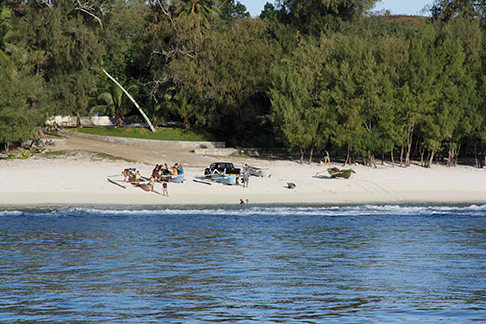
As Rimatara is not a port of entry we couldn’t go ashore, so before dusk we raised anchor and set sail on a fast 82-mile reach, then run, toward Rurutu. Upon rounding the northern tip of the island at dawn we decided to heave-to briefly off the tiny Moerai Harbor to let a small squall pass and gain a little more daylight.
The harbor was built specifically for Tuhaa Pae II, the small freighter owned by the Austral Islands that calls at Rurutu every couple of weeks. There were only two fishing-speedboats in the water and a few racing outrigger canoes visible onshore, so we could choose between dropping anchor and backing up to the harbor wall, or side-tying alongside the large black rubber ship fenders at the quay. We chose the second option and dropped the anchor several boat lengths off the wharf to help hold us off. This worked well, and with an unusual westerly wind there was almost no surge in the basin. By utilizing eight docklines and an anchor, Mahina Tiare rode quietly; only occasionally would our fenders touch the black ship’s fender.
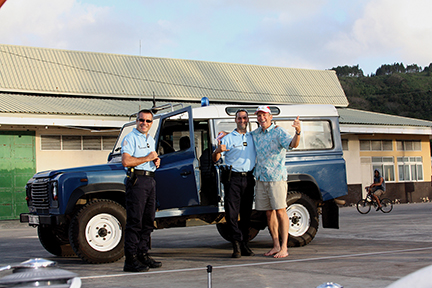
As soon as we completed mooring I hiked a half-mile to the Gendarmerie, not expecting them to be open at 9am Sunday morning. After buzzing the intercom installed on the outer gate, a Gendarme answered. He said he would stop by the boat at 2pm and that in the meantime, we were free to explore the island.
We each signed up for one-hour mooring watches and those not on watch took off exploring. The watches turned out to be very entertaining, as following church many locals came to check us out and take pictures. They all said it had been many years since a yacht had stopped. We invited many of the visitors aboard as they were curious to see below, wondering aloud what we ate and how we showered. Before long, gifts of fruit were piled high on the decks and invitations to tour the island were pouring in.
Mid-afternoon, the two friendly and efficient Gendarmes pulled up in their shiny blue Land Rover. As we were the first boat they had ever cleared in, they weren’t sure what to do so I helped them fill in their radio report form. They’d both previously been stationed on Martinique and said that compared to the rest of the world, Rurutu had very few problems.
Timothy, a young retired interpreter, and his wife took our gang to lunch and to see the largest cave, complete with massive stalactites and stalagmites. A short while later, a woman named Tiare arrived at the boat asking for Marta and we explained that she was out touring. Tiare had brought us generous portions of her family’s traditional Sunday feast, which included pork, taro and taro leaves, along with grated coconut fermented with a special small crab. Shy Tiare had brought her friend Marie, a vivacious young French-Italian who had arrived in Tahiti three years earlier as crew aboard a megayacht, to act as a translator. Both Marie and Tiare, who had never been on a yacht before, eagerly accepted an invitation to come aboard. Tiare’s three children were too scared to come along at first, but once mum was on the aft deck, they eagerly leapt aboard.
Marie offered many insights into the local culture. The Rurutu people have a very strong tradition of welcoming visitors; they want to make everyone feel at home. Marie said that from July to October each year, every guest bed on the island (55, mostly in family-run pensions) is fully booked with visitors from around the world coming to watch dozens of humpback whales mating and giving birth. She said that the few fishermen put aside fishing to take whale-watching guests in their boats, and that many people take the opportunity to swim with the whales.
We were extremely impressed by how polite the kids were. They hung about on the dock for hours, occasionally asking questions. Many of the boys had boogie boards and they loved to tell me about surfing waves near the harbor entrance, while Amanda enjoyed chatting about dance and sports with the girls.
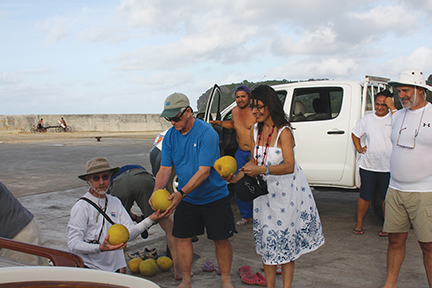
gifts-of-bananas-and-pamplemousse
Amanda taught winch servicing following breakfast and as she got to the end of her class a bevy of young beauties, all boarding students from Rimatara, stopped by. Before long, Amanda was on the wharf exchanging Maori haka dance moves. This brought gales of laughter from the girls, who then demonstrated Polynesian tamure dance. Our last visitors were a French couple from Brittany, both sailors. They happily helped cast off our lines as Marta guided Mahina Tiare out of the little harbor. There were people on either side of the harbor entrance, waving, laughing and shouting “Bon Voyage!” It felt a little sad to be leaving such a beautiful and friendly island so soon, and before long, we watched the magical little piece of paradise recede into the horizon.
We covered 166 miles in our first 24 hours after leaving Rurutu and the winds varied between 12 and 20 knots. We kept reducing sail to keep our boat speed below 8 knots, wanting to arrive off Tahiti’s Passe Taapuna before dawn. Today, Amanda taught sail repair, demonstrated double-braid splicing and gave the crew Turk’s head knots to master—all the more challenging in the strengthening conditions. Tahiti and Moorea started to give slight radar returns at 28 miles and we’re wondering if the bulk of Tahiti will provide some lee from the confused seas. With a full moon out, landfall along the Papara coast of Tahiti should be spectacular.
May 29, 2010, 0600 hrs,
17.28 S, 149.48 W
Log: 138,690 miles
At anchor off Moorea
As we neared the Taapuna pass Wednesday morning, our winds died to 4-5 knots, but we managed to ghost along while enjoying amazing views of Tahiti and Moorea at sunrise.
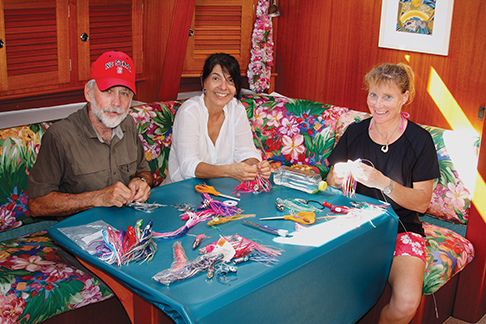
After tying up in Marina Taina, I headed to town to check in while Amanda taught the crew how to go aloft for rig checks. I’m happy to report that everyone made it safely up and down the mast. Upon my return I made lunch while the crew practiced using our new Sailrite sewing machine. In the afternoon, Amanda covered double-braid splicing and how to build fishing lures. James created a spectacular blue and sliver lure named Chepito (the singing debt collector), while Marta’s pink passion lure was christened Conchita.
Leg 1 is over and our crew departed with praises of a rewarding experience. Amanda and I are now anchored at the island of Moorea with surprisingly few boats. But we have a couple of days left here, so I’m sure we’ll encounter a few more boats and perhaps some old friends.
Since 1976, John Neal’s passion has been sharing his knowledge of ocean cruising. He has conducted 142 sail-training expeditions in the South Pacific, Patagonia, Antarctica, Atlantic, Scandinavia and the Arctic aboard

. Amanda Swan Neal has logged 242,000 miles, including two Sydney-Hobart Races and seven Cape Horn roundings, and is the author of The Essential Galley Companion. www.mahina.com.

















